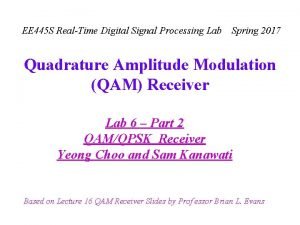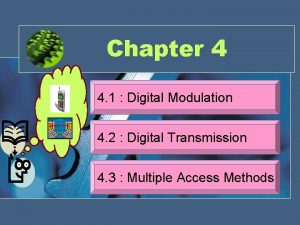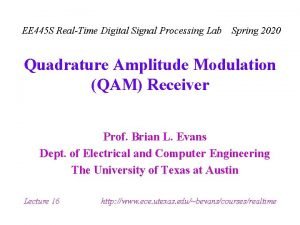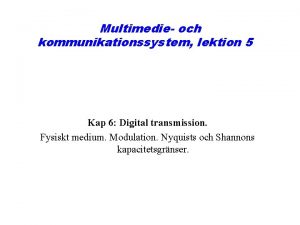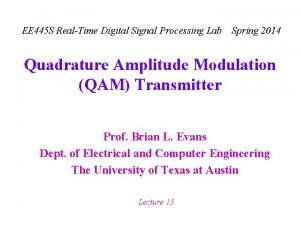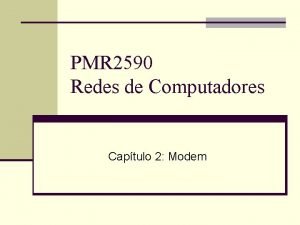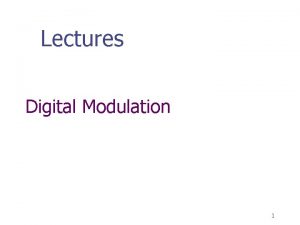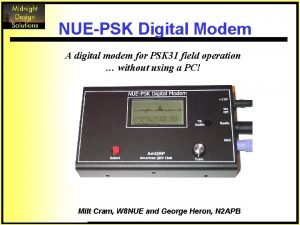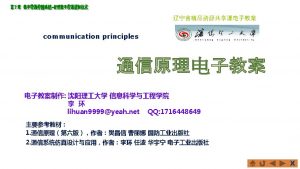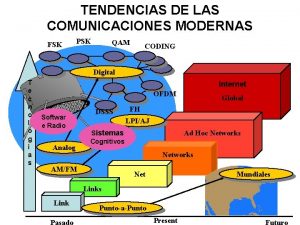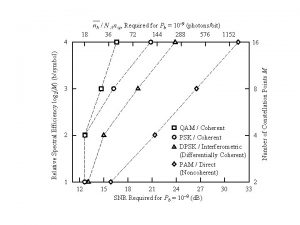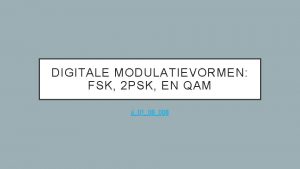Digital Communications Lecture 14 PSK QAM Sidra Shaheen















- Slides: 15

Digital Communications Lecture # 14 PSK & QAM Sidra Shaheen Syed Sidra. shaheen@iqraisb. edu. pk

Topical Overview • Pulse shift keying • Quadrature amplitude modulation

Phase Shift keying n n n The phase of the carrier is varied to represent binary 1 or 0. Both peak amplitude and frequency remain constant as the phase changes. If we start with a phase of 00 to represent binary 0, then we can change the phase to 1800 to send binary 1. The phase of the signal during each bit duration is constant, and its value depends on the bit (0 or 1). 2 -PSK or binary PSK: Two different phases (00 and 1800) are used. Constellation or phase-state diagram shows the relationship by illustrating only the phases.

PSK Constellation

PSK Constellations

PSK n Transmitted PSK Signal n PSK signals are constant energy signals

Relationship between Bit rate, Error Probability and Energy in PSK n n n Bit rate can be increased by increasing the numbers of points M in the constellation PSK But, by increasing the value of M, the distance between the points decreases and that may result in increased error probability in the presence of noise So, for increasing the bit rate without increasing error probability the radius of the circle needs to be increased n This increase in radius corresponds to increased energy n Therefore we need to transmit more power in order to transmit more bits per symbol

Circular Constellation of PSK Why? As we know Suppose we take two different basic unit energy signals as Where both of the above signals are orthogonal to eachother

Circular Constellation of PSK As the distance of points from the origin is same Therefore the energy which is the square of this distance will be same

Energy Distance Relationship As φ1(t) and φ2(t) are orthogonal to each otherefore the term So as all the signals lies on the circle therefore they will have same distance from origin and have constant energy

QAM n n Combining ASK and PSK, we could have x variations in phase and y variations in amplitude, giving us x times y possible variations and the corresponding number of bits per variation. Quadrature amplitude modulation does that. Quadrature amplitude modulation is a combination of ASK and PSK so that a maximum contrast between each signal unit is achieved. In 4 -QAM and 8 -QAM, number of amplitude shifts is fewer than the number of phase shifts. Because amplitude changes are susceptible to noise and require greater shift differences than do phase changes, the number of phase shifts used by a QAM system is always larger than the number of amplitude shifts. High level M-ary schemes (such as 64 -QAM) are very bandwidth-efficient but more susceptible to noise and require linear amplification

QAM

Constellation of QAM n n QAM is a generalization it may not need to lie on a circle This polar representation shows the joint modulation of amplitude and phase

Constellation of QAM

 Pulsos: pam, ppm, pwm, pcm, ask, fsk, psk, qam
Pulsos: pam, ppm, pwm, pcm, ask, fsk, psk, qam Shaheen project
Shaheen project Shaheen khurana
Shaheen khurana Qam transmitter
Qam transmitter 32 qam truth table
32 qam truth table Qam transmitter
Qam transmitter 8 qam constellation
8 qam constellation 15 degree phase shift transformer
15 degree phase shift transformer Qam circuit
Qam circuit Crisis communication lecture
Crisis communication lecture 01:640:244 lecture notes - lecture 15: plat, idah, farad
01:640:244 lecture notes - lecture 15: plat, idah, farad Psk 31
Psk 31 Psk
Psk Psk lorentz
Psk lorentz Phase shift keying bandwidth
Phase shift keying bandwidth Nue-psk
Nue-psk



